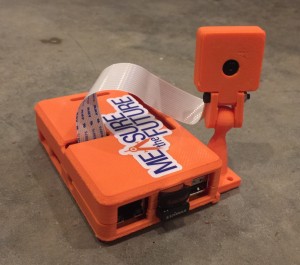Thus far in the development process for Measure the Future I’ve been working to ensure that I understood the need and was heading down a path that librarians found valuable. I did this via a survey given to both of my Alpha partners as well as linked in Library Journal, and after sorting through the dozens of responses I had a much clearer picture of what the community saw as valuable, and what maybe could wait for the version 2 of the project.
 The next step was proof of concept for the hardware, which I put together and demoed at the ALA Annual conference in San Francisco in July. That demo went very well, with yet more awesome feedback and renewed interest from libraryland to push us forward. The hardware demos were great, and people seemed to like the progress we were making.
The next step was proof of concept for the hardware, which I put together and demoed at the ALA Annual conference in San Francisco in July. That demo went very well, with yet more awesome feedback and renewed interest from libraryland to push us forward. The hardware demos were great, and people seemed to like the progress we were making.
Now is the time in the project that I’ve been working towards since ALA Annual. I knew that the project needed a particular skill set to move forward, and that I probably needed more than one person to make it happen. I needed someone with a solid understanding of computer vision, someone who’s worked with the sorts of problems inherent with using cameras as a data source. And I needed someone who had a great head for turning numbers into meaning, that could look at the data from the sensors and make those numbers work for the libraries in question. I know how everything fits together, but I learned a long time ago that it’s faster to find experts than it is to try to learn everything that I might need to accomplish a project. So I did just that…found two experts that I’m beyond thrilled to work with.
 The first is Clinton Freeman, a software developer from Cairns, Australia. Clinton was introduced to me by the amazing Daniel Flood of The Edge in Queensland, Australia. If you aren’t aware of the things they are doing at The Edge, they (like much of Australian librarianship) are way out in front of the future of the profession, making it happen. Clinton worked with them on a couple of projects, and has a history of working with computer vision to do really interesting things…the more Daniel told me about him, the more I knew he was the right guy for the job. I contacted him and laid out the problems we are trying to solve, and how I see it coming together, and in short order he was sold enough to join the team. Clinton understands the library world, and is going to be working on testing and improving my initial hardware work, the computer vision analysis, and API development for the project.
The first is Clinton Freeman, a software developer from Cairns, Australia. Clinton was introduced to me by the amazing Daniel Flood of The Edge in Queensland, Australia. If you aren’t aware of the things they are doing at The Edge, they (like much of Australian librarianship) are way out in front of the future of the profession, making it happen. Clinton worked with them on a couple of projects, and has a history of working with computer vision to do really interesting things…the more Daniel told me about him, the more I knew he was the right guy for the job. I contacted him and laid out the problems we are trying to solve, and how I see it coming together, and in short order he was sold enough to join the team. Clinton understands the library world, and is going to be working on testing and improving my initial hardware work, the computer vision analysis, and API development for the project.
The second new member of the team is someone who I can almost literally say needs no introduction, at least to the U.S. cadre of online librarians. I needed someone that could take the raw data coming off the sensors and write elegant algorithms to identify patterns and derive areas of interest from the flood of numbers…and do so with a keen eye on what librarians need to know (and more importantly, how not to overwhelm them with information). An amazing developer that groks libraries, is a math wizard, and can do front end web dev with the best of them? That’s a description custom-made for Andromeda Yelton if ever I saw one, and I’m beyond thrilled that she’s agreed to work with Clinton and I on the development of the project.
So this takes my team up to 6 total: myself, my alpha partner libraries represented by Gretchen Caserotti and Jenica Rogers, my amazing hardware advisor from Sparkfun Electronics Jeff Branson, and my development team in Clinton and Andromeda. The development team is in the process of setting development milestones now, in prep for a sprint from now until ALA Midwinter in Boston, where I hope to have the next round of demo hardware with some UI and UX to show off. Our timeline has always been targeting ALA Annual 2016 in Orlando to have the project ready for libraries to use, and I feel more confident than ever that we are going to do just that.
Expect some more reports as we set specific goals for the next few months, as there’s nothing like public expectation to make one hit deadlines. Here we go!